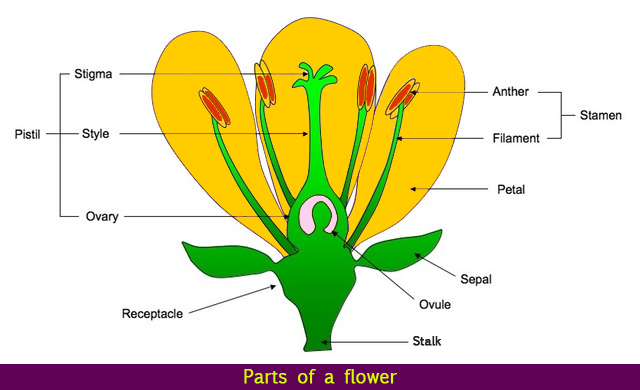
List the different parts of the flower.
Answer
408k+ views
Hint: Sepals, petals, stamens, and carpels are the four primary components of most flowers. The stamens are the male component of the flower, while the carpels are the female part. The majority of flowers are hermaphrodites, meaning they have both male and female components. Others may be masculine or female and contain one of the two parts.
Complete answer:
Before moving on to the sections, familiarise yourself with the classification of flowers.
The flower's stalk is known as the peduncle.
The section of the flower to which the stem is attached is known as the receptacle. It is small and located in the centre of the flower's base.
Sepals: The little, leaf-like portions that sprout at the base of the petals are known as sepals. They make up the flower's outermost whorl. The calyx is the collective name for the sepals. The calyx and its sepals' primary role is to protect the flower before it blooms (in the bud stage).
Petals: Just above the sepal layer is the layer of petals. They are generally brightly coloured because their primary purpose is to attract pollinators to the flower, such as insects and butterflies. The corolla is the collective name for the petals.
The male portions of a flower are called stamens. The androecium is the collective name for a group of stamens. They are grouped into two sections structurally:
Filament: the long, slender portion that connects the anther to the flower.
Anthers: The anthers are the stamen's heads, and they're in charge of creating pollen, which is then transferred to the pistil or female portions of the same or another flower to fertilise it.
The female portions of a flower are formed by the pistil. The gynoecium is a group of pistils.
Pistils are made up of three major components:
1) the stigma, which is a sticky tip that collects pollen grains;
2) the style, which is a long neck that joins the stigma and the ovary; and
3) the ovary, which produces ovules.

Note: A bisexual flower has all four whorls, including petals, sepals, male reproductive structure (stamen), and female reproductive structure (ovules) (pistil). As a result, it is often known as a perfect or entire flower.
Complete answer:
Before moving on to the sections, familiarise yourself with the classification of flowers.
The flower's stalk is known as the peduncle.
The section of the flower to which the stem is attached is known as the receptacle. It is small and located in the centre of the flower's base.
Sepals: The little, leaf-like portions that sprout at the base of the petals are known as sepals. They make up the flower's outermost whorl. The calyx is the collective name for the sepals. The calyx and its sepals' primary role is to protect the flower before it blooms (in the bud stage).
Petals: Just above the sepal layer is the layer of petals. They are generally brightly coloured because their primary purpose is to attract pollinators to the flower, such as insects and butterflies. The corolla is the collective name for the petals.
The male portions of a flower are called stamens. The androecium is the collective name for a group of stamens. They are grouped into two sections structurally:
Filament: the long, slender portion that connects the anther to the flower.
Anthers: The anthers are the stamen's heads, and they're in charge of creating pollen, which is then transferred to the pistil or female portions of the same or another flower to fertilise it.
The female portions of a flower are formed by the pistil. The gynoecium is a group of pistils.
Pistils are made up of three major components:
1) the stigma, which is a sticky tip that collects pollen grains;
2) the style, which is a long neck that joins the stigma and the ovary; and
3) the ovary, which produces ovules.

Note: A bisexual flower has all four whorls, including petals, sepals, male reproductive structure (stamen), and female reproductive structure (ovules) (pistil). As a result, it is often known as a perfect or entire flower.
Recently Updated Pages
The correct geometry and hybridization for XeF4 are class 11 chemistry CBSE

Water softening by Clarks process uses ACalcium bicarbonate class 11 chemistry CBSE

With reference to graphite and diamond which of the class 11 chemistry CBSE

A certain household has consumed 250 units of energy class 11 physics CBSE

The lightest metal known is A beryllium B lithium C class 11 chemistry CBSE

What is the formula mass of the iodine molecule class 11 chemistry CBSE

Trending doubts
State the laws of reflection of light

One Metric ton is equal to kg A 10000 B 1000 C 100 class 11 physics CBSE

Difference Between Prokaryotic Cells and Eukaryotic Cells

How do I convert ms to kmh Give an example class 11 physics CBSE

Describe the effects of the Second World War class 11 social science CBSE

Which of the following methods is suitable for preventing class 11 chemistry CBSE




